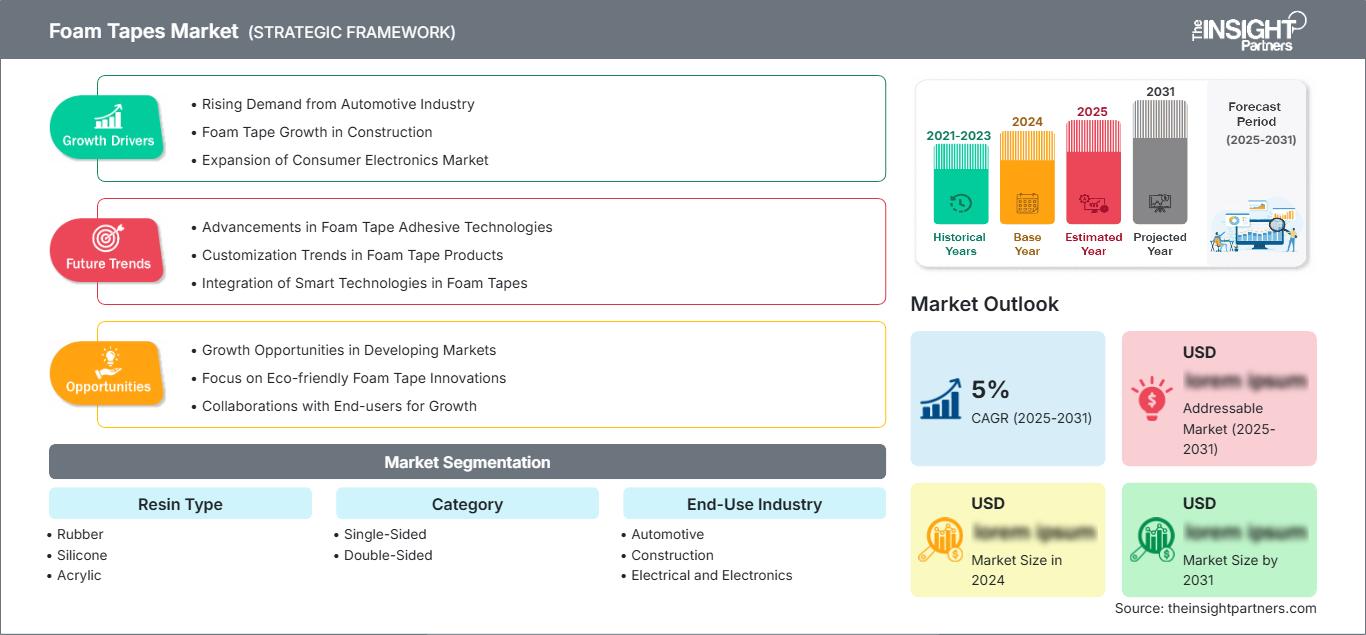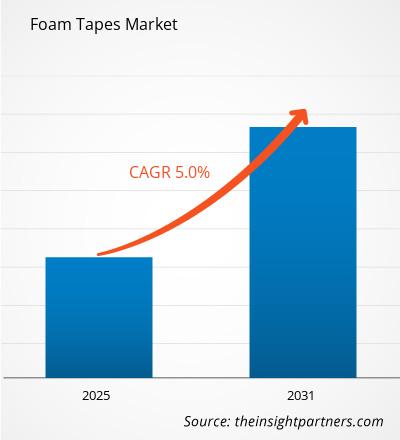Der Markt für atmungsaktive Folien wird bis 2031 voraussichtlich ein Volumen von 16,92 Milliarden US-Dollar erreichen. Für den Zeitraum 2025–2031 wird ein jährliches Wachstum von 6,8 % erwartet.
Der Bericht zum Markt für Schaumstoffklebebänder ist nach Harztyp (Gummi, Silikon, Acryl und andere) segmentiert. Er enthält außerdem Analysen basierend auf der Produktkategorie (einseitig und doppelseitig) und der Endverbrauchsbranche (Automobilindustrie, Bauwesen, Elektrotechnik und Elektronik, Verpackung und andere). Die globale Analyse wird weiter auf regionaler Ebene und für wichtige Länder aufgeschlüsselt. Marktgröße und Prognosen auf globaler, regionaler und Länderebene für alle wichtigen Marktsegmente sind im Bericht enthalten. Die Werte für die oben genannten Analysen und Segmente werden in US-Dollar angegeben. Der Bericht liefert wichtige Statistiken zum Marktstatus der wichtigsten Marktteilnehmer und zeigt Markttrends und -chancen auf.
Zweck des Berichts
Der Bericht „Markt für Schaumstoffklebebänder“ von The Insight Partners beschreibt die aktuelle Marktlage und das zukünftige Wachstum sowie die wichtigsten Triebkräfte, Herausforderungen und Chancen. Dies wird verschiedenen Akteuren im Geschäftsbereich Einblicke ermöglichen, wie beispielsweise:
- Technologieanbieter/Hersteller: Um die sich entwickelnde Marktdynamik zu verstehen und potenzielle Wachstumschancen zu erkennen, können sie fundierte strategische Entscheidungen treffen.
- Investoren: Um eine umfassende Trendanalyse hinsichtlich Marktwachstumsrate, Finanzprognosen und Chancen entlang der Wertschöpfungskette durchzuführen.
- Regulierungsbehörden: Um Richtlinien zu regulieren und Aktivitäten auf dem Markt zu überwachen, mit dem Ziel, Missbrauch zu minimieren, das Vertrauen der Anleger zu wahren und die Integrität und Stabilität des Marktes zu gewährleisten. Marktsegmentierung für Schaumstoffklebebänder: Harztyp: Gummi, Silikon, Acryl. Kategorie: Einseitig, Doppelseitig. Anwendungsbranche: Automobilindustrie, Bauwesen, Elektrotechnik und Elektronik, Verpackung. Geografie: Nordamerika, Europa, Asien-Pazifik, Süd- und Mittelamerika, Naher Osten und Afrika.
Passen Sie diesen Bericht Ihren Anforderungen an
Sie erhalten kostenlos Anpassungen an jedem Bericht, einschließlich Teilen dieses Berichts oder einer Analyse auf Länderebene, eines Excel-Datenpakets sowie tolle Angebote und Rabatte für Start-ups und Universitäten.
Markt für Schaumstoffbänder: Strategische Einblicke

-
Holen Sie sich die wichtigsten Markttrends aus diesem Bericht.Dieses KOSTENLOSE Beispiel umfasst Datenanalysen, die von Markttrends bis hin zu Schätzungen und Prognosen reichen.
Wachstumstreiber für Schaumstoffklebebänder
- Steigende Nachfrage aus der Automobilindustrie: Der Markt für Schaumstoffklebebänder wird maßgeblich von der Automobilindustrie angetrieben. In der Fahrzeugherstellung werden Schaumstoffklebebänder in großem Umfang zum Kleben, Abdichten und Isolieren eingesetzt. Mit der zunehmenden Globalisierung stehen Fahrzeughersteller vor der Herausforderung, die Fahrzeugleistung zu verbessern, das Gewicht zu reduzieren und den Kraftstoffverbrauch zu senken. Dementsprechend steigt der Bedarf an Schaumstoffklebebändern und anderen leichten und effektiven Klebelösungen. Darüber hinaus treibt die Entwicklung elektrifizierter Transportmittel in Form von Elektrofahrzeugen (EVs) die Nachfrage nach Dichtungs- und Isolierlösungen an, die aufgrund des verbesserten Wärme- und Geräuschmanagements in diesen Fahrzeugen im Vergleich zu konventionellen Fahrzeugen noch fortschrittlichere und nachhaltigere Lösungen darstellen.
- Wachstum von Schaumstoffklebebändern im Bauwesen: Ein weiterer wichtiger Treiber für den Markt für Schaumstoffklebebänder ist das Wachstum im Bauwesen. Schaumstoffklebebänder werden in dieser Branche zur Isolierung, Wetterfestmachung und Abdichtung eingesetzt. Weltweit wächst der Druck hin zu energieeffizientem Bauen und nachhaltigen Bauweisen. Dies führt zu einer steigenden Nachfrage nach Schaumstoffklebebändern, die zur Abdichtung von Lufteinschlüssen und damit zu einem besseren thermischen Komfort eingesetzt werden. Darüber hinaus hat die veränderte Bauweise, insbesondere im Wohnungsbau, den Bedarf an Schaumstoffklebebändern erhöht, da Bauherren nach effizienten Methoden suchen, Öffnungen abzudichten und die Wärmedämmung zu verbessern.
- Expansion des Marktes für Unterhaltungselektronik: Das rasante Wachstum der Unterhaltungselektronikbranche hat ebenfalls zum Wachstum des Marktes für Schaumstoffklebebänder beigetragen. Grund dafür ist die steigende Nachfrage nach Anwendungen wie Montage, Polsterung und Schwingungsdämpfung. Schaumstoffklebebänder werden bei der Herstellung vieler elektronischer Geräte wie Smartphones, Fernseher und Haushaltsgeräte verwendet. Mit dem technologischen Fortschritt verändern sich nicht nur die Anwendung, sondern auch das Design von Geräten. Anwender bevorzugen zunehmend robustere Ausführungen, was die Nachfrage nach spezialisierten Schaumstoffklebebändern erhöht, die ihren Zweck optimal erfüllen.
Zukunftstrends im Markt für Schaumstoffklebebänder
- Fortschritte bei Klebstofftechnologien für Schaumstoffklebebänder: Die kontinuierliche Verbesserung von Klebstofftechnologien erklärt die jüngste Entwicklung von Hochleistungs-Schaumstoffklebebändern mit hervorragender Haftung. Hersteller arbeiten an Klebebändern, die auf den meisten Oberflächen haften, auch auf schwierigen wie Kunststoffen und Metallen. Diese Entwicklungen erweitern das Anwendungsspektrum von Schaumstoffklebebändern in verschiedenen Branchen.
- Trends bei der Individualisierung von Schaumstoffklebebändern: Wie bei den meisten Produkten auf dem Markt, die sich durch die Verbraucher modifizieren lassen, ist auch bei Schaumstoffklebebändern ein Trend zur Individualisierung zu beobachten. So können beispielsweise Dicke, Dichte und die Klebeseite je nach Anwendungszweck angepasst werden. Mit ihrem erweiterten Angebot können die Hersteller spezialisierte Nischenmärkte erschließen und ihre Kunden zufriedenstellen, was zu deren Loyalität und wiederholten Käufen führt.
- Integration intelligenter Technologien in Schaumstoffbänder: Die Integration intelligenter Technologien in Schaumstoffbänder ist ein weiterer Trend. Einige Unternehmen erforschen die Möglichkeit, Sensoren und IoT-Elemente in die Schaumstoffbänder zu integrieren, um deren Leistungsfähigkeit zu steuern. Intelligente Bänder können Daten zu Temperatur, Luftfeuchtigkeit und Zugfestigkeit übertragen, sodass Anwender die Bänder optimal an die jeweiligen Anwendungen anpassen und deren Lebensdauer verlängern können. Dies unterstützt auch den zunehmend dominanten Trend zu intelligenten Gebäuden und fortschrittlicher Fertigung.
Marktchancen für Schaumstoffbänder
- Wachstumschancen in Entwicklungsländern: Der Markt für expandierende Schaumstoffbänder bietet interessante Perspektiven in Entwicklungsländern, in denen industrielles Wachstum und die Ausdehnung von Städten im Vordergrund stehen. Dieser Trend kann weiter ausgebaut werden, indem Unternehmen ihre Präsenz und ihre Produkte in diesen Märkten gezielt entwickeln. Die Einrichtung lokaler Produktionsstätten und Liefernetzwerke kann die Lieferkette stärken und die Verfügbarkeit von Schaumstoffklebebändern für lokale Unternehmen in diesen Gebieten verbessern.
- Fokus auf umweltfreundliche Schaumstoffklebeband-Innovationen: Hersteller haben gute Chancen, sich auf Forschung und Entwicklung umweltfreundlicher Schaumstoffklebebänder zu konzentrieren und entsprechend zu investieren. Da die Industrie zunehmend umweltbewusster wird, ist die Verwendung biologisch abbaubarer und ungiftiger Materialien ein wichtiger Wettbewerbsvorteil für die Unternehmen. Die Integration praktischer Produkte in die Strategie trägt zur weiteren Stärkung der Marke und zur Gewinnung neuer Kundengruppen umweltbewusster Anwender bei.
- Kooperationen mit Endverbrauchern für Wachstum: Es wird erwartet, dass Synergien mit Endverbrauchern von Schaumstoffklebebändern zur Entwicklung dieses Marktes beitragen. Joint Ventures mit Herstellern und Händlern von Endverbrauchern sowie branchenübergreifende oder akademische Kooperationen können zu neuen, auf spezifische Branchen zugeschnittenen Rezepturen und Anwendungen führen. Solche Partnerschaften ermöglichen beiden Seiten zudem den Austausch von Ressourcen, was das Wachstum in dieser Branche fördert.
Schaumstoffklebebandmarkt
Die regionalen Trends und Einflussfaktoren auf den Markt für Schaumstoffklebebänder im gesamten Prognosezeitraum wurden von den Analysten von The Insight Partners ausführlich erläutert. Dieser Abschnitt behandelt außerdem die Marktsegmente und die geografische Verteilung des Marktes für das Management von Herzrhythmusstörungen in Nordamerika, Europa, Asien-Pazifik, dem Nahen Osten und Afrika sowie Süd- und Mittelamerika.
Umfang des Marktberichts zu Schaumstoffbändern
By Kategorie- einseitig
- doppelseitig
- Automobilindustrie
- Bauwesen
- Elektro- und Elektronikindustrie
- Verpackung
- Nordamerika
- Europa
- Asien-Pazifik
- Süd- und Mittelamerika
- Naher Osten und Afrika
- Großbritannien
- Deutschland
- Frankreich
- Russland
- Italien
- Restliches Europa
- China
- Indien
- Japan
- Australien
- Restlicher Asien-Pazifik
- Brasilien
- Argentinien
- Restliches Süd- und Mittelamerika
- Südafrika
- Saudi-Arabien
- Vereinigte Arabische Emirate
- Restlicher Naher Osten und Afrika
Berichtsattribut Einzelheiten Marktgröße in 2024 US$ XX Billion Marktgröße nach 2031 US$ 16.92 Billion Globale CAGR (2025 - 2031) 6.8% Historische Daten 2021-2023 Prognosezeitraum 2025-2031 Abgedeckte Segmente By Harztyp - Gummi
- Silikon
- Acryl
Abgedeckte Regionen und Länder Nordamerika - USA
- Kanada
- Mexiko
Marktführer und wichtige Unternehmensprofile - 3M Co
- Adchem Corporation
- Adhere Industrial Tapes Ltd
- Avery Dennison Corporation
- CCT Tapes
- Halco
- Lintec Corporation
- Lohmann GmbH and Co. Kg
- Nitto Denko Corporation
Dichte der Akteure im Markt für Schaumstoffbänder: Auswirkungen auf die Geschäftsdynamik
Der Markt für Schaumstoffklebebänder wächst rasant, angetrieben durch die steigende Nachfrage der Endverbraucher. Gründe hierfür sind unter anderem sich wandelnde Verbraucherpräferenzen, technologische Fortschritte und ein wachsendes Bewusstsein für die Vorteile des Produkts. Mit steigender Nachfrage erweitern Unternehmen ihr Angebot, entwickeln innovative Lösungen, um den Verbraucherbedürfnissen gerecht zu werden, und nutzen neue Trends, was das Marktwachstum zusätzlich beflügelt.

- Holen Sie sich die Markt für Schaumstoffbänder Übersicht der wichtigsten Akteure
Wichtigste Verkaufsargumente
- Umfassende Abdeckung: Der Bericht bietet eine umfassende Analyse der Produkte, Dienstleistungen, Typen und Endnutzer des Marktes für Schaumstoffklebebänder und vermittelt so ein ganzheitliches Bild.
- Expertenanalyse: Der Bericht basiert auf dem fundierten Wissen von Branchenexperten und Analysten.
- Aktuelle Informationen: Der Bericht gewährleistet Geschäftsrelevanz durch die Berücksichtigung aktueller Informationen und Datentrends.
- Anpassungsmöglichkeiten: Dieser Bericht kann an spezifische Kundenanforderungen angepasst werden und sich optimal in die Geschäftsstrategien integrieren.
Der Forschungsbericht zum Markt für Schaumstoffklebebänder kann somit maßgeblich dazu beitragen, das Branchenszenario und die Wachstumsaussichten zu entschlüsseln und zu verstehen. Auch wenn einige berechtigte Bedenken bestehen, überwiegen die Vorteile dieses Berichts insgesamt die Nachteile.
-
- Historische Analyse (2 Jahre), Basisjahr, Prognose (7 Jahre) mit CAGR
- PEST- und SWOT-Analyse
- Marktgröße Wert/Volumen – Global, Regional, Land
- Branchen- und Wettbewerbslandschaft
- Excel-Datensatz
Aktuelle Berichte
Erfahrungsberichte
Grund zum Kauf
- Fundierte Entscheidungsfindung
- Marktdynamik verstehen
- Wettbewerbsanalyse
- Kundeneinblicke
- Marktprognosen
- Risikominimierung
- Strategische Planung
- Investitionsbegründung
- Identifizierung neuer Märkte
- Verbesserung von Marketingstrategien
- Steigerung der Betriebseffizienz
- Anpassung an regulatorische Trends






















 Kostenlose Probe anfordern für - Markt für Schaumstoffbänder
Kostenlose Probe anfordern für - Markt für Schaumstoffbänder